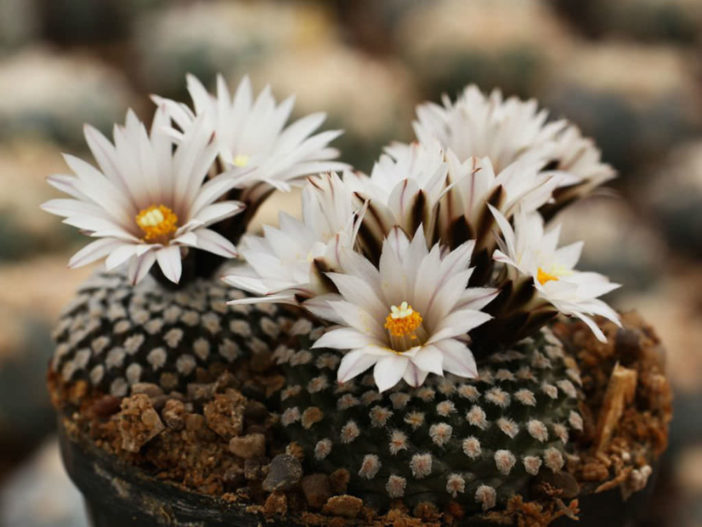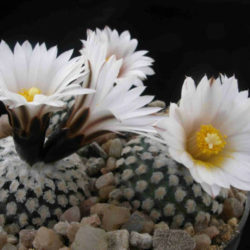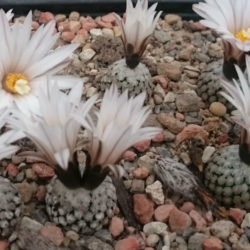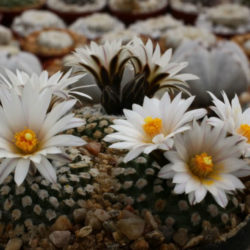Scientific Name
Turbinicarpus valdezianus var. albiflorus (Pazout) M.Zachar, R.Staník, A.Lux & I.Dráb
Synonym(s)
Gymnocactus valdezianus var. albiflorus, Neolloydia valdeziana var. albiflora, Pelecyphora valdeziana var. albiflora, Pseudosolisia valdeziana var. albiflora
Scientific Classification
Family: Cactaceae
Subfamily: Cactoideae
Tribe: Cacteae
Genus: Turbinicarpus
Description
Turbinicarpus valdezianus var. albiflorus is a dwarf cactus with a green, usually solitary stem with hatchet-shaped, spirally arranged tubercles covered by short pectinate spines. The stem grows up to 2 inches (5 cm) tall and 0.8 inches (2 cm) in diameter, initially spherical with a depressed apex, becoming cylindrical with age. Each areole bears about 25 to 30 distinctive white radial spines that spread horizontally, forming small umbrellas on the tips of the tubercles. The central spines are absent.
Flowers are funnel-shaped with lance-shaped, white to pinkish petals with a pink midrib and appear from late winter to early spring at the top of the stem. They are up to 1 inch (2.5 cm) long and 1.2 inches (3 cm) in diameter. Fruits are spherical to barrel-shaped, dark greenish-brown, and contain tiny dark brown seeds.
Origin
Turbinicarpus valdezianus var. albiflorus is not accepted as a variety and is listed as a form of Turbinicarpus valdezianus. It is native to Mexico and occurs north of Matehuala in San Luis Potosí.

Hardiness
USDA hardiness zones 9b to 11b: from 25 °F (−3.9 °C) to 50 °F (+10 °C).
How to Grow and Care
Turbinicarpus prefer to be in a well-ventilated position in full sun to maintain a good body color and spinal development. The golden rule regarding watering is "never water when the soil is still damp." This is the one error that will certainly kill any plant. Watering should commence in the spring, depending on the weather conditions. The plants should initially be given a light spray to gently encourage them into growth.
These cacti can withstand high summer temperatures and benefit from being accompanied by good ventilation. Do not be tempted to overcrowd the plants; they will be far happier with a little space to allow the air to circulate. Winter temperatures can be low at 44 to 46 °F (7 to 8 °C). Indeed the plants need these low temperatures to ensure a sustained dormant period resulting in good growth and flowering the following growing season.
Learn more at How to Grow and Care for Turbinicarpus.
Links
- Back to genus Turbinicarpus
- Succupedia: Browse succulents by Scientific Name, Common Name, Genus, Family, USDA Hardiness Zone, Origin, or cacti by Genus
Photo Gallery
Click on a photo to see a larger version.


